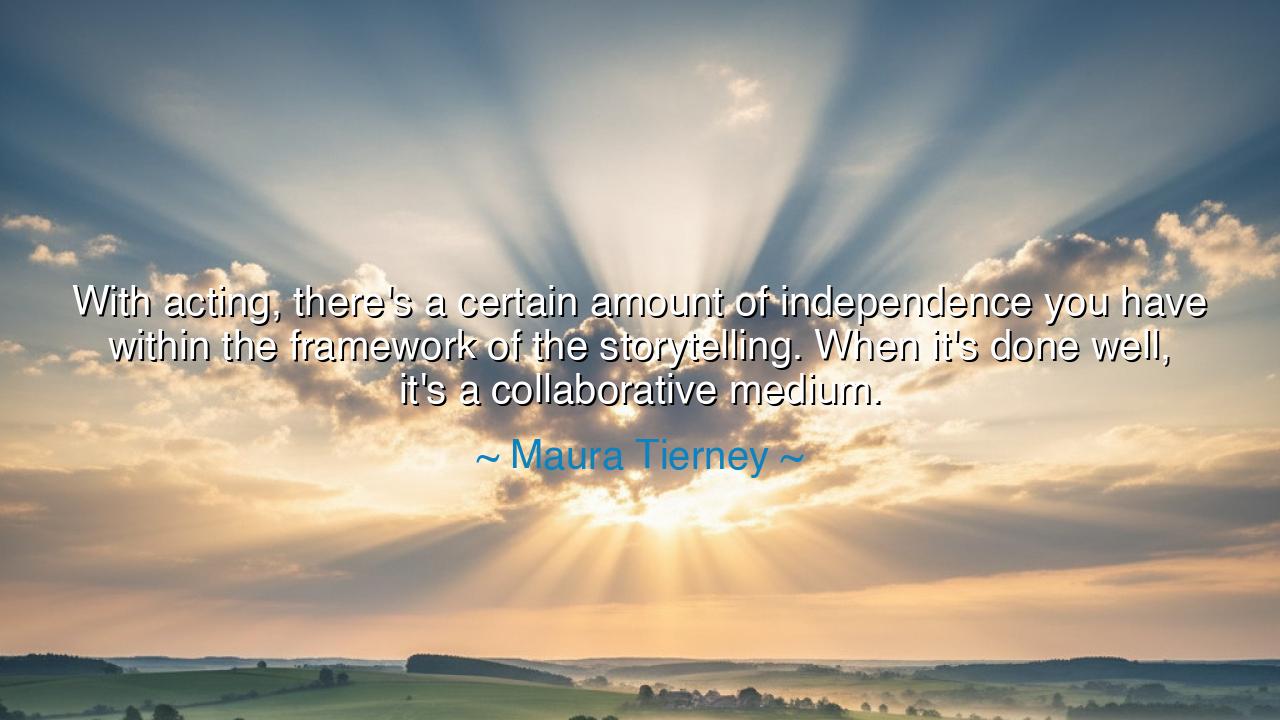
With acting, there's a certain amount of independence you have
With acting, there's a certain amount of independence you have within the framework of the storytelling. When it's done well, it's a collaborative medium.






The actress and storyteller Maura Tierney once spoke with quiet insight about the nature of her craft: “With acting, there’s a certain amount of independence you have within the framework of the storytelling. When it’s done well, it’s a collaborative medium.” In these few words lies the balance of all creative endeavor — the harmony between independence and collaboration, between the voice of the individual and the song of the collective. It is a truth not only for artists, but for all who labor to bring beauty, meaning, or purpose into the world. For the greatest works are not born of isolation, nor are they forged by obedience alone; they arise when freedom moves in rhythm with unity, when one’s unique fire illuminates rather than consumes the shared flame.
At the heart of Tierney’s reflection lies the paradox that defines all art: the artist must be both autonomous and united, both free and bound. The actor brings their own spirit, history, and emotion into a role — this is the independence Tierney speaks of. Yet this independence lives within a larger world, a framework — the storytelling, the vision of the writer, director, and ensemble. To act is to surrender and to assert, to listen and to speak in equal measure. When done well, Tierney reminds us, acting becomes a collaborative medium, where each participant gives and receives, creating something larger than themselves. It is a sacred dance — each performer moving to their own rhythm, yet never breaking the music of the whole.
The origin of this wisdom can be traced to the oldest forms of human expression. In the amphitheaters of ancient Greece, actors were not solitary stars but vessels for myth. Each wore masks not to hide themselves, but to reveal something universal — to merge their individuality with the voice of the gods, the chorus, and the people. The playwright Sophocles could craft the structure, but it was through the actors’ courage, gestures, and tone that tragedy came to life. In this way, they embodied Tierney’s truth: the actor’s independence flourished only within the bounds of shared purpose. The same balance guided the sculptors of cathedrals, the poets of ancient courts, and the musicians of royal halls — each free in their artistry, yet serving a greater design.
Consider, too, the story of the great Japanese actor Toshiro Mifune and his partnership with director Akira Kurosawa. Mifune’s power lay in his raw independence — his movement fierce, his presence untamed. Kurosawa, the master storyteller, shaped that energy through structure and vision. Their union produced films that transcended cinema, capturing the spirit of humanity itself. Alone, each was remarkable; together, they became legendary. So it is with Tierney’s wisdom: independence becomes strength only when it finds its place in service to the whole.
There is also a moral echo within her words — a teaching that extends beyond art to life itself. In any community, family, or nation, each soul carries a measure of freedom, a voice uniquely their own. Yet, if that voice refuses harmony, it becomes noise. If it loses itself entirely, it becomes silence. True strength lies in collaboration, in knowing how to contribute one’s gifts without overshadowing others. Just as an actor must trust the director’s vision and their fellow performers, so must each of us trust the rhythm of the greater story we inhabit — the story of our shared humanity.
Tierney’s insight reminds us that independence is not rebellion, but responsibility — the ability to bring one’s best self to the collective work. The true artist does not demand control; they seek communion. They find freedom not in dominance, but in participation. This lesson, though drawn from acting, applies to all crafts — to teachers who work in teams, to scientists who labor in shared discovery, to citizens who build nations. The most enduring creations, whether a film, a movement, or a civilization, are those where individuals honor their own truth while upholding the structure that binds them together.
Thus, let this teaching be carried forward: whether upon the stage or in the stage of life, learn the art of collaborative independence. Nurture your voice, yet listen deeply to others. Shape your craft, but honor the framework that gives it meaning. Do not seek to shine alone — for the truest light is that which joins others in illuminating the whole. As Maura Tierney reminds us, the highest form of freedom is not isolation, but contribution — the joy of finding one’s own rhythm within the timeless song of the world.






AAdministratorAdministrator
Welcome, honored guests. Please leave a comment, we will respond soon